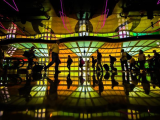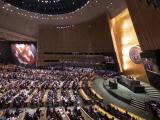Feb 16, 2010 (CIDRAP News) – Employees without paid sick days were more likely to work when they were sick during the peak of the fall pandemic wave and may have extended the outbreak by infecting their coworkers, according to a research group.
Using data from the US Centers for Disease Control and Prevention (CDC) and the US Department of Labor, the investigators estimate that almost 26 million employed Americans age 18 and older may have been infected with the pandemic H1N1 virus from September through November. They projected that nearly 18 million took at least a part of a week off due to illness and that 8 million apparently worked while they were sick.
The researchers, from the Institute for Women's Policy Research (IWPR), published their findings on Feb 8 on the organization's Website. According to an earlier IWPR estimate, four fifths of low-wage workers lack defined paid sick days, a situation that is more likely to affect women, minorities, and young workers who are on the lower end of pay scales—categories that also match some of the groups at risk from H1N1 flu complications.
Robert Drago, PhD, coauthor of the report, said in a press release from the group that working while sick is a public health issue and that those who worked while they were infected with the pandemic H1N1 virus this fall may have infected as many as 7 million coworkers. Drago is professor of labor studies and women's studies at Pennsylvania State University.
Central to the report are comparisons between absence rates before and after the fall flu peak between workers in public-sector jobs, which are more likely to have paid sick leave, and those working in the private sector, who have less access to paid sick days.
Kevin Miller, PhD, a senior research fellow at IWPR and coauthor of the report, said in the press release that the findings suggest that only two thirds of private-sector employees took time off work when they were infected with the pandemic H1N1 virus. "Workers without paid sick days must choose whether to go to work sick or lose pay, a choice that many can't afford to make," he said.
The United States is one of a few developed nations that doesn't have universal paid sick days, which the IWPR and others have said impairs the nation's response to infectious disease outbreaks. According to the IWPR, 89% of state and local government employees and nearly all federal employees have paid sick days, but only two of five private-sector employees have paid sick leave coverage.
Congressional members have introduced legislation making paid sick leave the national standard, but the topic spurred controversy during a legislative hearing in November as the nation's fall pandemic activity was peaking. Though some members of Congress framed the issue as a public health risk to workers and the general public, others pointed out that compulsory paid sick leave could hurt small businesses and work against flexible paid-time-off policies that others have instituted.
Study details
The researchers made their projections and comparisons using CDC data during the weeks of the fall peak and the US Bureau of Labor Statistics' Current Population Survey data on work absences covering September, October, and November.
In September and October, absence rates for workers in both sectors rose, the public sector by 84% (1.9 percentage points) and the private sector by 66% (1.2 percentage points).
Though absence rates for both groups declined in November from the October peak, the decline was less steep for those in the private sector (8.9%) compared with the public sector (21.8%).
"The discrepancy in the drop-off may indicate that infections in the private sector continued at a higher rate than in the public sector as the result of presenteeism connected to lower rates of access to paid sick days," the researchers wrote. They added that the same patterns in the two groups are seen during seasonal flu outbreaks.
They pointed out that some of the results from comparing absences with employment sectors didn't achieve statistical significance, which they said isn't surprising with only 3 months' of data. However, they said the results are "sensible," with the same patterns between the two work sectors seen over the past three flu seasons.
"The public sector results suggest that the vast majority of employees infected withH1N1 would have stayed home if that were a viable option," they wrote.
Business perspectives
A. Bruce Clarke, an attorney who is president and CEO of Capital Associated Industries, a North Carolina non-profit with 1,000 member businesses, told CIDRAP News that one key flaw in the study is that it doesn't take into account that people come to work sick, regardless of their paid sick leave status. "Not many people stay home at the first sign. We are often mid illness before it makes any sense to be gone," he said.
He also added that some groups that support a national paid sick leave policy underreport the percentage of employers who offer paid time off—with some only counting paid sick days that are specifically labeled. He said that, according to his own survey, 86% of employers offer paid time off that can be used as sick leave. He said a US Department of Labor survey of manufacturers has revealed that 96% have paid time off that can be used during illnesses.
Lisa Koonin, MN, MPH, a senior adviser with the CDC's influenza coordination unit, said it's important to keep in mind that it's not always easy to distinguish when an employee is working sick. She said some flu infections are so mild the employee might not realize he or she is sick. Also, she said the CDC's illness projections account for the presences of illnesses that are not influenza.
She said the bottom line is for employers to have more flexible sick leave policies during health emergencies. "This is something to think about, especially when the threat is severe," Koonin said.
"Not all businesses can have the same policy" she said, adding that in a public health emergency, examining ways to make sick leave policies more flexible makes sense and is just one part of a comprehensive strategy to make the workplace safer for employees.
See also:
Feb 8 Institute for Women's Policy Research pandemic H1N1sick leave study
http://www.iwpr.org/press-room/archive/lack-of-paid-sick-days-allowed-h1n1-to-spread-in-the-workplace/view
Nov 17, 2009, CIDRAP News story "Sick-leave standard as anti-flu weapon stirs debate"

















